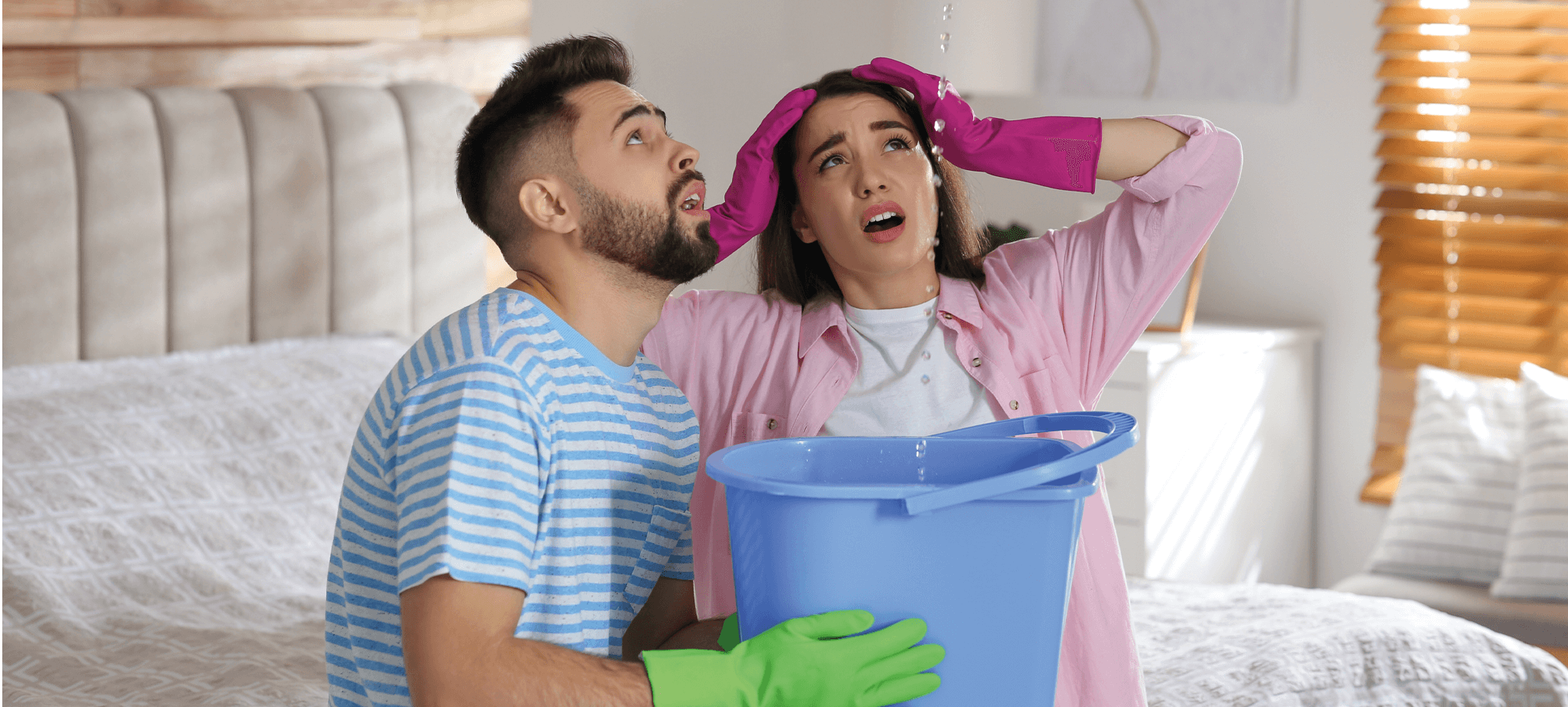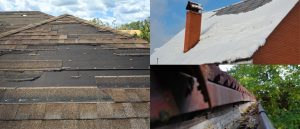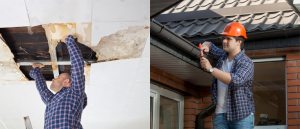Is Your Roof Leaking in Heavy Rain? Here’s Why & What to Do
Published Date: June 6, 2023

One of the primary purposes of a roof is to shield your home from weather elements such as rain, wind, and snow. However, when a roof leak occurs, it can lead to disastrous consequences, including mold problems and structural damage.
There’s no time to lose if you notice roof leaks in heavy rain. Read on to learn more about roof leaks and how to address this problem.
Identifying the Roof Leak
If you suspect you have a leaky roof, you can take a few steps to diagnose the issue. You should start by looking for interior signs of a leak:
- Yellow stains and brown spots on the ceiling are sure signs of a leak. During heavy rain, you might also feel wet spots on the ceilings or drywall.
- Water dripping in your home can affect the plumbing and cause wet and rusty pipes.
- Water leaks often result in mold growth. You’ll notice a musty or stale smell throughout your home.
- Humidity levels can feel high, and you might see signs of condensation.
How do I track a leak in my first-floor ceiling? If you notice water stains inside, your next step should be to conduct an external inspection to look for additional signs of water leaks:
- Missing, cracked, or curled shingles are a common sign that water is getting into your home.
- You might also see holes in your roof due to missing boot covers or flashing.
- If granules clog the gutters, you likely have damaged shingles that could lead to water damage.
- Sometimes, water will pool underneath the siding and cause a bulge to appear in an exterior wall.
Spotting a water leak is easier if you know what to look for and where to check. Here are the most common spots for roof damage:
- Roof valleys are spots where two segments of your roof meet at an angle. Water will naturally pool in these areas.
- If you have a leak in a metal roof, check the metal screws that secure the roofing panels to your home.
- A damaged roof ridge cap can let water in.
- Skylights, windows, and dormers are common culprits. These elements need proper flashing to act as a sealant.
- All homes have plumbing vents. A damaged vent pipe or vent stack without proper flashing can be an entry point for raindrops.
- Damaged or missing eaves and soffits can let wind-driven rain inside your home.
Takeaway: Homeowners often notice roof leaks due to indoor humidity, mold, and moisture spots on the ceilings. If you notice any of these signs, look for missing shingles and check flashing, roof valleys, and other spots likely to sustain damage.
Causes of Roof Leaks During Heavy Rain or Storm
If you have roof leaks in heavy rain, there is likely damage to your roof that lets water in once raindrops pool in a specific spot.
Here are some common causes:

- Your roof could be missing a few roof tiles or have damaged shingles. Water will pool in these areas and enter your home.
- If you have a flat roof, damage to the roofing material or poor drainage can result in water leaks during storms.
- Flashing creates a tight seal around air vents, chimneys, windows, and other elements. Missing or damaged flashing will let water in.
- In cold climates, ice and snow can form dams on your roof. As the ice and snow melt, water will get under the tiles or shingles.
- Clogged gutters often cause water to pool and damage the eaves.
- Ridge vents let hot air out of your attic in the summer, but a damaged ridge vent is a common entry point for rainwater.
Takeaway: Roof leaks in heavy rain often stem from damage to the roofing materials or poor drainage.
Immediate Steps to Take When Your Roof Leaks
If you notice a wet patch that is increasing or have some water dripping in your living room, there are a few emergency steps you can take:
- Catch the water with a bucket or use a funnel to redirect it.
- Turn the electricity off to prevent water from contacting appliances and electronics.
- Move furniture and other items out of the way to limit water damage.
- Turn your ceiling fan on and your bathroom exhaust fan to dry your home.
- Remove carpets and upholstery so these items don’t absorb humidity and cause mold to appear.
- Find a hotel or a friend who can take you in for the night.
Takeaway: Your priority should be to protect your belongings from the water and stay safe.
Solutions for Repairing a Leaky Roof
You should look into your roof repair options as soon as the storm passes. A water leak is a severe problem that will only lead to further damage to your home.
Temporary Fixes to Repair a Leaking Roof from the Inside
A temporary fix can keep water out of your home while you wait for a contractor to repair your roof. Here are your options:
- Once you locate where the leak is coming from, you can cover the damaged area by hanging plastic sheets or tarps in your attic.
- A diverter is another inexpensive solution for catching and redirecting water.
- You can use patches or plugs to keep the water out of your attic for small leaks.
Options for Replacement of the Roof
Does a leak mean that you need a new roof? Not necessarily. If the leak comes from missing flashing, a few curled shingles, or a damaged roof ridge cap, a contractor can fix these elements without replacing the entire roof.
However, if your roof has extensive signs of damage or is approaching the end of its lifespan, replacement is often your best option.
There are two main options to consider:
- Re-roofing is a budget-friendly solution. It consists of installing a new layer of shingles over an existing roof. Not all roofs are candidates for re-roofing.
- You can opt for a full roof replacement. A contractor will remove the existing roofing material and install a new roof.
Depending on the state of your roof, you might need additional repairs to your home's roof sheathing or structure. The average cost of getting a new roof is around $8,000, but many factors can influence this price tag.
There are different materials to consider if you’re looking into getting a new roof:
- Metal roofs are gaining in popularity. They represent an upfront investment, but they last longer, and you’ll typically see a 60% return when you sell your home.
- Shingles remain popular, but there is a wide range of materials to choose from, including metal, asphalt, or slate shingles.
- Tiles tend to cost more, but they’re a more durable solution compared to shingles. You can find clay, concrete, or synthetic tiles.
Call the Professionals
If there is a leak in your home or apartment, your top priority should be to find a reputable roofer.
If the leak stems from a minor issue, the contractor will perform an emergency repair to protect your home from further leaks.
If you need a roof repair, the contractor will typically offer a temporary fix or install a diverter to protect your home from water damage.
They will then plan the roof replacement. Installing a new roof takes two to three days, but planning the job and ordering the materials can take a few weeks. This process can take even longer if the roofing contractor has to schedule the job around inclement weather.
Here are a few tips:
- Don’t hesitate to call more than one roofer so you can compare quotes or get a second opinion.
- A roofer must see your home in person to determine whether you need a repair or replacement. Anyone who claims otherwise doesn’t have your best interest in mind.
- Ask questions and do some research. Find out more about different replacement options and roofing materials to choose the best solution for your needs and budget.
Takeaway: If you have a leaky roof, you can protect your home with a temporary fix to stop or divert the water, but calling a roofer should be a priority.
Our Top Picks for Professional Roofing Contractors
Do you need help finding a reputable roofing company? Here are the best roofing companies we recommend.
CMR Construction & Roofing
Known For Craftsmanship Excellence
With over 20 years of experience and a presence in 32 states, CMR Construction & Roofing is one of the largest roofing companies in the country. Here’s why we recommend this award-winning contractor:
- You can expect a fast response. CMR Construction & Roofing complete most emergency repairs within 24 to 48 hours.
- This company offers high-quality roofing systems that represent excellent value.
- They also offer services like siding, windows, and gutters. It’s a great way to save money if you’re fixing extensive damage to your home.
You’ll get a ten-year warranty on labor, and the warranty on materials varies based on the manufacturer.
Lowe's
Known For Nationwide Reach
This well-known home improvement chain partners with local contractors to offer roofing repair and installation services. You should consider working with Lowe’s for the following reasons:
- Lowe's has professional independent installers who are background-checked.
- Due to its large size, Lowe’s can offer great prices on roofing materials and supplies.
- Lowe’s offers a quick and easy financing process for your project.
The default warranty on labor lasts two years, but you can purchase an extended warranty that lasts 25 years.
Aspen Contracting Inc.
Known For Eco-Friendly Services
Aspen Contracting is another contractor we recommend. This company has offices nationwide and stands out thanks to its excellent customer service and focus on quality.
Here’s what to expect from Aspen Contracting:
- It’s an innovative company that uses drone imagery to plan jobs and offers synthetic and eco-friendly materials.
- Aspen Contracting has an unparalleled quality control process to ensure during repairs and installation.
- This contractor offers a 24/7 roofing emergency service for urgent repairs.
You’ll get a lifetime warranty on everything Aspen Contracting does, which adds value.
Takeaway: Not sure who to call for roofing repair? We recommend CMR Construction & Roofing, Lowe’s, or Aspen Contracting.
DIY Vs. Professional for Roof Leak Repair
A DIY repair is a realistic option for a temporary fix or a small repair, such as patching damaged flashing or replacing a few shingles.
However, there are some important considerations:

- Over 300 workers die yearly from falls, with 80% occurring in the construction industry. Climbing on the roof yourself is dangerous; you shouldn’t attempt it without the proper equipment.
- You’ll need to select the right roofing materials and supplies.
- You’ll also need a few tools, such as a roofing nail gun, air compressor, roofing blade, shingle snake tool, and more.
While a DIY repair can be tempting, it’s best to call a professional. A licensed and insured contractor will know how to climb on the roof safely. They’ll have the expertise to recommend the best roofing materials; their work will last years.
Takeaway: A DIY repair can help you save money, but calling a professional is much safer and more effective.
Dangers of Ignoring a Roof Leak During Heavy Rain
A roof leak isn’t a problem that will go away by itself. If you fail to take action, water damage will spread throughout your home.
It can affect structural elements such as walls and ceilings. It can cause pipes to rust, making your electrical system a hazard. Humidity also creates ideal conditions for mold and pests to thrive.
Takeaway: Ignoring a roof leak will lead to further damage and more expensive repairs.
Bottom Line
A roof leak in heavy rain often comes from roof damage or poor drainage. You should take immediate action to limit water damage and look for a contractor who can fix the issue or discuss roof replacement with you.
FREQUENTLY ASKED QUESTIONS (FAQs)
How Long Before a Leak Causes Damage?
A leak can cause damage immediately by staining walls and ceilings with water spots. Mold and structural damage typically develop over a few months.
Why Does My Roof Only Leak Sometimes?
Roofs may leak occasionally due to various factors. One common reason is the presence of damaged or worn-out roofing materials, such as cracked shingles or deteriorated flashing. Weather conditions can also play a role, as heavy rain or snow can expose vulnerabilities in the roof’s protective layers. Additionally, leaks may occur if there are issues with the roof’s design, such as inadequate slope or improper installation.
Why Is Water Dripping from My Ceiling After Heavy Rain?
The most likely explanation is that water seeps through your roof due to damaged or missing shingles or flashing.
Is It Safe to Stay in a House With a Leaky Roof?
It depends on how bad the leak is and how well you can clean or redirect the water. It’s best to shut off the power and look for a place to stay to be on the safe side.
Can a Leaking Ceiling Collapse?
It can happen, but a ceiling won’t collapse unless there is extensive water damage and prolonged exposure to water.
Why Is Water Leaking Into My Basement Ceiling After Heavy Rain?
Water can trickle down to the basement along the walls, but you might also see signs of water damage caused by groundwater entering your basement.
Will a Wet Ceiling Dry on Its Own?
As long as the damp spot is small, a wet ceiling can dry independently. It’s best to use fans and dehumidifiers to accelerate this process.
Is It Normal for Roofs to Leak in Heavy Rain?
The answer is no. A leak is a sign of a damaged roof in need of repair.
How Long Does It Take for Mold to Grow from a Leaking Roof?
It only takes 24 hours for mold and mildew to grow on a damp surface.
Should I call a Roofer or Insurance First?
If your roof sustained damage in an event covered by your insurance policy, contact your insurance first. Otherwise, it’s best to schedule a roofing inspection and repair as quickly as possible.
How Much Does It Cost to Fix a Leaky Ceiling?
A roof repair can cost anywhere from $400 to $1,000, depending on the extent of the damages and the roofing materials to replace.




